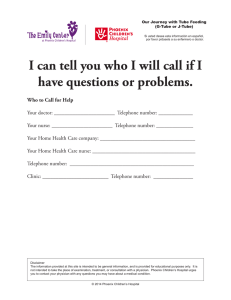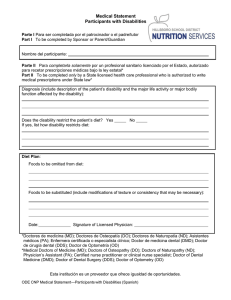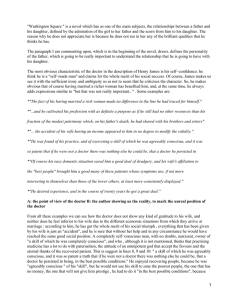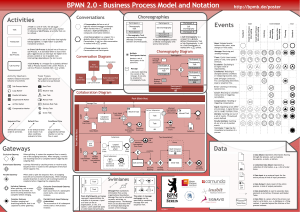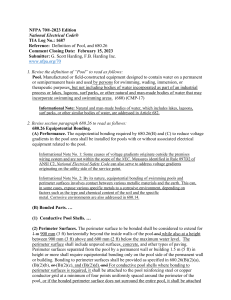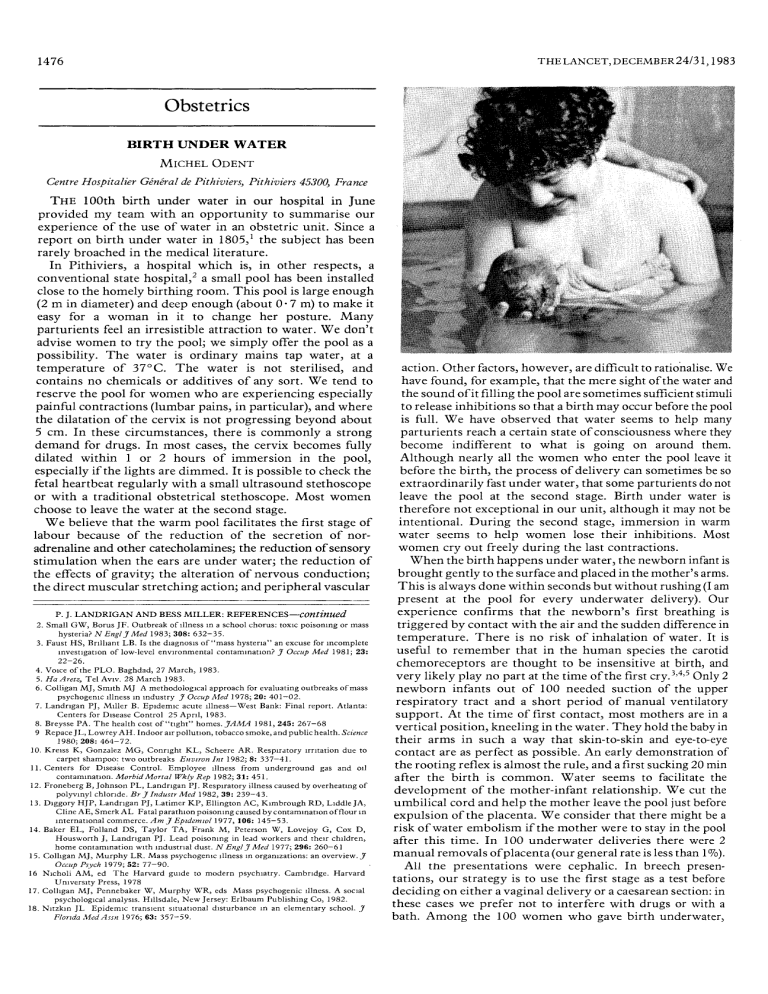
1476 Obstetrics BIRTH UNDER WATER MICHEL ODENT Centre Hospitalier Général de Pithiviers, Pithiviers 45300, France THE 100th birth under water in our hospital in June provided my team with an opportunity to summarise our experience of the use of water in an obstetric unit. Since a report on birth under water in 1805,1 the subject has been rarely broached in the medical literature. In Pithiviers, a hospital which is, in other respects, a conventional state hospital,2 a small pool has been installed close to the homely birthing room. This pool is large enough (2 m in diameter) and deep enough (about 0 - 7 m) to make it easy for a woman in it to change her posture. Many parturients feel an irresistible attraction to water. We don’t advise women to try the pool; we simply offer the pool as a possibility. The water is ordinary mains tap water, at a temperature of 37 °C. The water is not sterilised, and contains no chemicals or additives of any sort. We tend to reserve the pool for women who are experiencing especially painful contractions (lumbar pains, in particular), and where the dilatation of the cervix is not progressing beyond about 5 cm. In these circumstances, there is commonly a strong demand for drugs. In most cases, the cervix becomes fully dilated within 1 or 2 hours of immersion in the pool, especially if the lights are dimmed. It is possible to check the fetal heartbeat regularly with a small ultrasound stethoscope or with a traditional obstetrical stethoscope. Most women choose to leave the water at the second stage. We believe that the warm pool facilitates the first stage of labour because of the reduction of the secretion of noradrenaline and other catecholamines; the reduction of sensory stimulation when the ears are under water; the reduction of the effects of gravity; the alteration of nervous conduction; the direct muscular stretching action; and peripheral vascular in a school chorus: toxic poisoning or mass 632-35. 3. Faust HS, Brilliant LB. Is the diagnosis of"mass hysteria" an excuse for incomplete investigation of low-level environmental contamination? J Occup Med 1981; 23: 22-26. 4. Voice of the PLO. Baghdad, 27 March, 1983. 5. Ha Aretz, Tel Aviv. 28 March 1983. 6. Colligan MJ, Smith MJ A methodological approach for evaluating outbreaks of mass psychogenic illness in industry J Occup Med 1978; 20: 401-02. 7. Landrigan PJ, Miller B. Epidemic acute illness-West Bank: Final report. Atlanta: Centers for Disease Control 25 April, 1983. 8. Breysse PA. The health cost of "tight" homes. JAMA 1981, 245: 267-68 9 Repace JL, Lowrey AH. Indoor air pollution, tobacco smoke, and public health. Science 1980; 208: 464-72. 10. Kreiss K, Gonzalez MG, Conright KL, Scheere AR. Respiratory irritation due to carpet shampoo: two outbreaks Environ Int 1982; 8: 337-41. 11. Centers for Disease Control. Employee illness from underground gas and oil contamination. Morbid Mortal Wkly Rep 1982; 31: 451. 12. Froneberg B, Johnson PL, Landrigan PJ. Respiratory illness caused by overheating of polyvinyl chloride. Br J Industr Med 1982, 39: 239-43. 13. Diggory HJP, Landrigan PJ, Latimer KP, Ellington AC, Kimbrough RD, Liddle JA, 2. Small GW, Borus JF. Outbreak of illness hysteria? N Engl J Med 1983; 308: Cline AE, Smerk AL Fatal parathion poisoning caused by contamination of flour in international commerce. Am J Epidemiol 1977, 106: 145-53. 14. Baker EL, Folland DS, Taylor TA, Frank M, Peterson W, Lovejoy G, Cox D, Housworth J, Landrigan PJ. Lead poisoning in lead workers and their children, home contamination with industrial dust. N Engl J Med 1977; 296: 260-61 15. Colligan MJ, Murphy LR. Mass psychogenic illness in organizations: an overview. J Occup Psych 1979; 52: 16 Nicholi 77-90. AM, ed The Harvard guide to modern psychiatry. Cambridge. Harvard University Press, 1978 17. Colligan MJ, Pennebaker W, Murphy WR, eds Mass psychogenic illness. A social psychological analysis. Hillsdale, New Jersey: Erlbaum Publishing Co, 1982. 18. Nitzkin JL Epidemic transient situational disturbance in an elementary school. J Florida Med Assn 1976; 63: 357-59. action. Other factors, however, are difficult to rationalise. We have found, for example, that the mere sight of the water and the sound ofit filling the pool are sometimes sufficient stimuli to release inhibitions so that a birth may occur before the pool is full. We have observed that water seems to help many parturients reach a certain state of consciousness where they become indifferent to what is going on around them. Although nearly all the women who enter the pool leave it before the birth, the process of delivery can sometimes be so extraordinarily fast under water, that some parturients do not leave the pool at the second stage. Birth under water is therefore not exceptional in our unit, although it may not be intentional. During the second stage, immersion in warm water seems to help women lose their inhibitions. Most women cry out freely during the last contractions. When the birth happens under water, the newborn infant is brought gently to the surface and placed in the mother’s arms. This is always done within seconds but without rushing (I am present at the pool for every underwater delivery). Our experience confirms that the newborn’s first breathing is triggered by contact with the air and the sudden difference in temperature. There is no risk of inhalation of water. It is useful to remember that in the human species the carotid chemoreceptors are thought to be insensitive at birth, and very likely play no part at the time of the first cry. 1,4,1 Only 2 newborn infants out of 100 needed suction of the upper respiratory tract and a short period of manual ventilatory support. At the time of first contact, most mothers are in a vertical position, kneeling in the water. They hold the baby in their arms in such a way that skin-to-skin and eye-to-eye contact are as perfect as possible. An early demonstration of the rooting reflex is almost the rule, and a first sucking 20 min after the birth is common. Water seems to facilitate the development of the mother-infant relationship. We cut the umbilical cord and help the mother leave the pool just before expulsion of the placenta. We consider that there might be a risk of water embolism if the mother were to stay in the pool after this time. In 100 underwater deliveries there were 2 manual removals of placenta (our general rate is less than 1%). All the In breech presentations, strategy is to use the first stage as a test before deciding on either a vaginal delivery or a caesarean section: in these cases we prefer not to interfere with drugs or with a bath. Among the 100 women who gave birth underwater, presentations our were cephalic. 1477 were 43 primiparas, 37 secundiparas, 14 para 3, 2 para 4, one para 5, one para 6, and one para 7. The youngest was 19 there and the oldest was 43. The average age was 28. The lowest birth weight was 215 kg and the highest was 4 - 40 kg. We did not perform any episiotomies. All the tears (of which there were 29) were first degree. We had no infectious complications, even where the membranes were already broken. There were no perinatal deaths. One infant was transferred to a paediatric unit one day after the birth with groaning and respiratory failure, symptoms which were diagnosed as subarachnoid haemorrhage after delivery in the posterior position at 37 weeks. Only one infant was jaundiced and required phototherapy (15 mg/dl bilirubin on the second day). One of the infants born under water died suddenly some weeks later, although it was previously considered to be perfectly healthy. We have found no risk attached either to labour or to birth under water, and in any hospital where a pool is in daily use, a birth under water is bound to happen now and then. Compared with the supported squatting position in the Point of View we have found that the end of the second stage be more difficult under water, particularly for primiparas, but immersion during the second half of the first stage of labour is helpful, particularly for parturients having painful and inefficient contractions. It should be possible for any conventional hospital to have a pool situated close to the birthing room and operating theatre. The use of warm water during labour requires further research, but we hope that other experience would confirm that immersion in warm water is an efficient, easy, and economical way to reduce the use of drugs and the rate of intervention in parturition. birthing room, of labour can REFERENCES 1. 2. 3. 4. 5. M. Observation accouchement termine dans le bain. Ann Soc Méd Prat Embry Montpellier 1805; 5: 13. Gillett J. Childbirth in Pithiviers, France. Lancet 1979; ii: 894-96. Girard F, Lacaisse A, Dejours P. Le stimulus O 2 ventilatoire à la période néonatale chez l’homme. J Physiol (Paris) 1960; 52: 108-09. Purves MJ The effects of hypoxia in the newborn lamb before and after denervation of the carotid chemoreceptors. J Physiol 1966; 185: 60-77. Purves MJ. Chemoreceptors and their reflexes with special reference to the fetus and newborn. J Devl Physiol 1981, 3: 21-57. sur un Caller: "Gracious no! And you So inviolable is THE SAMARITANS AND THE MEDICAL PROFESSION GEORGE H. DAY* Honorary Consultant to the Samaritans young rural general practitioner some 50 years ago, I hopping mad when a patient of mine, whose "back trouble" I had been attempting to treat for weeks on end, sneaked off to a backstreet Bonesetter and gained instant relief. The incident struck at my self-esteem and exposed my ineptitude. I felt belittled in the eyes of my patient-who thereby forfeited my love-and of his circle of friends and relations (who would assuredly crow over his miracle cure and my discomfiture). Human nature being what it is, and mine being no better than it should be, I could well understand the doctor who angrily warned a patient: "It’s either me or the Samaritans. If you go to the Samaritans I can’t have anything more to do with you"-a classic display of Bonesetter Syndrome. More recently, at a meeting of my local psychiatric club, I overheard a colleague moaning to the guest speaker: "These bloody Samaritans! They hang on to our depressed patients and we don’t get a chance to treat them". (Nobody then knew that I was a Samaritan volunteer. When it eventually emerged, I was eased out, and received no further notification of future meetings. Boohoo!) All this happened some years ago, but suspicion and unease about the Samaritans still lurk among some doctors and psychiatrists. How can we Samaritans persuade them that they have nothing to fear from us, when it is not strictly true? Like radiologists, the Samaritans are equipped to be able occasionally to detect underlying causes of distress which are not immediately apparent to the eyes and ears of a timeconstrained doctor. Our equipment consists of unlimited time-hours after hours-for openended listening. These fire-side colloquies can create a rapport deeper than that achieved during a surgery attendance, and can prompt such "shameful" disclosures as: Myself (wearing my Samaritan hat after two hours’ audition): "But you say you have been to your GP. Didn’t you tell him all this?" As a was *Mundesley House, Mundesley, Norwich NR11 8AE. are not to tell him either, please". confidentiality that, unlike the communicate with a caller’s doctor without the caller’s consent. If consent is refused, we find ourselves in the invidious position of knowing more about a patient as an individual and his circumstances than his doctor does-a sort of Bonesetter oneupmanship on the doctor-which brings its own problems. After all, qualified paramedical ancillaries, nurses, and social workers are dutybound not only to relay their findings to the doctor but also to work under his or her direction. radiologist, our we cannot ETHICS The General Medical Council booklet’ refers (p 10) to nurses and other persons who have been trained to perform specialised functions", and who presumably hold certificates or diplomas to that effect. It gives, however, no guidance for Bonesetters and Samaritans, both of whom, like psychoanalysts, learn their skills during an apprenticeship. It goes on to say (p 11): "a doctor who improperly delegates to a person who is not a registered medical practitioner functions requiring the knowledge and skill ofa medical practitioner is liable to disciplinary proceedings". (I shudder to think of the times an unqualified old gamp has wielded the chloroform bottle at one end of a parturient woman while I fumbled at the other end. Would my plea that it was in the patient’s best interest have enabled me to get away with it?) Does this mean that in no circumstance can a doctor collaborate with "unqualified" Samaritans? The legal position is by no means clear but, in fact, many doctors do collaborate amicably with the Samaritans, and vice versa, with no breach of confidentiality on either side. "care by DISPIRITMENT The vast majority (about 85%) of our callers suffer from dispiritment. They may have been prostrated by an unheralded personal tragedy-a ruptured love-life, an overwhelming disappointment, bereavement, or similar misfortunes. Or they are being ground down by a worsening life-situation-the loneliness of a bed-sitter or the cold silences ofa crumbling marriage. These people are desperate, crushed and battered, and often within an ace of throwing in the towel. They are unbearably lonely in their plight and






